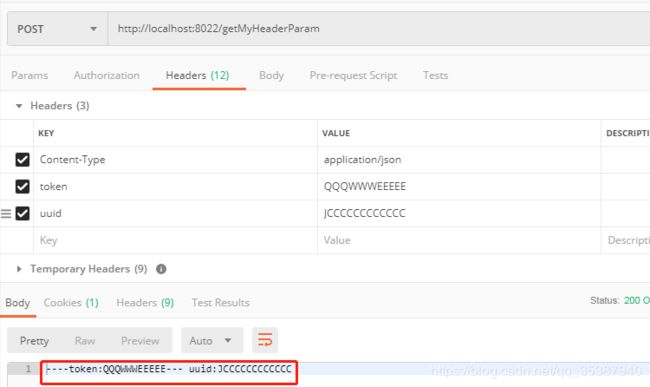Springboot 最细节全面的接口传参接参介绍,总有你喜欢的一种方式
这篇里面对每种传参接参方式都会举出较多的例子,不多说,入正题:
@PathVariable
一
@GetMapping("/getId/{id}")
public String pathVariableTest(@PathVariable Integer id) {
return "id: "+id;
}二
@GetMapping("/getId/{id}")
public String pathVariableTest(@PathVariable("id") Integer id) {
return "id: "+id;
}三
@GetMapping("/getId/{idValue}")
public String pathVariableTest(@PathVariable("idValue") Integer id) {
return "id: "+id;
}以上三种方式的调用结果都是成功的:
虽然说三种方式都是成功的,但是推荐使用第二种,也就是明确地指定对应参数对应名称。
第一种方式不注明参数名称的,仅仅在单个参的时候选择使用。
最后给出推荐使用的第二种方式的传接多参例子:
@GetMapping("/getIdAny/{id}/{name}")
public String pathVariableTestAny(@PathVariable("id") Integer id,@PathVariable("name") String name) {
return "**id: "+id+" **name: "+name;
}调用结果(http://localhost:8023/getId/1001/JCccc):
@RequestParam
一
@GetMapping("/getId")
public String requestParamTest( Integer id) {
return "id: "+id;
}二
@GetMapping("/getId")
public String requestParamTest( @RequestParam Integer id) {
return "id: "+id;
}三
@GetMapping("/getId")
public String requestParamTest( @RequestParam("id") Integer id) {
return "id: "+id;
}以上三种方式都是可以正常调用的:
四
@GetMapping("/getId")
public String requestParamTest( @RequestParam("idValue") Integer id) {
return "id: "+id;
}第四种,可以看到在@RequestParam里面给参数id取名为: idValue,这时候传参时参数名称也需要写成idValue即可。
那么以上四种方式,我推荐第三种,也就是规范地注解命名对应参数名称。
最后给出推荐使用的第三种方式的传接多参例子:
@GetMapping("/getIdAny")
public String requestParamTestAny( @RequestParam("id") Integer id,@RequestParam("name") String name,@RequestParam Integer age) {
return "**id: "+id+" **name: "+name+" **age: "+age;
}调用结果(http://localhost:8023/getIdAny?id=1002&name=JCccc&age=10):
针对使用@RequestParam,补充一下上传文件的是需要注意的以及方式:
简单示例一下怎么接收以及传递文件(使用MultipartFile接收):
@ResponseBody
@PostMapping("upload")
public String upload(@RequestParam("myFile") MultipartFile file) {
return "---file name:" + file.getOriginalFilename()+
"---file type:" + file.getContentType()+
"---file size:" + file.getSize();
}
@RequestBody
PS:对应RequestBody的使用,方式其实是比较多的,可以耐心看看,传参以json格式传递,接收方式较多(一定要记住Content-Type为application/json)
通过实体类接参的方式:
User.java:
PS:Get 方式 和 Post方式 其实都是可以有requestBody的,只不过一般来说post用的较多(后面都用post方式举例)。
@GetMapping("/getRequestBodyValue")
public String RequestBodyTest(@RequestBody User user) {
return user.toString();
}调用结果:
通过Map接参的方式:
单独获取参通过map的get方法根据key获取即可
@PostMapping("/getRequestBodyValue")
public String RequestBodyTest(@RequestBody Map userMap) {
return userMap.toString();
}调用结果:
通过JsonObject接参的方式:
这里用到了fastjson的依赖包:
com.alibaba
fastjson
1.2.7
@PostMapping("/getRequestBodyValue")
public String RequestBodyTest(@RequestBody JSONObject jsonObject) {
Integer id = jsonObject.getInteger("id");
String name = jsonObject.getString("name");
Integer age = jsonObject.getInteger("age");
return "---id:"+id+" ---name:"+name+" ---age:"+age;
}
调用结果:
通过String接参数的方式:
这种情况是先使用String把body里面的数据获取出来,再转换成jsonobject再进行参数解析
@PostMapping("/getRequestBodyValue")
public String RequestBodyTest(@RequestBody String jsonStr) {
JSONObject jsonObject= JSON.parseObject(jsonStr); //将jsonStr转化为JSONObject,再进行取值
Integer id = jsonObject.getInteger("id");
String name = jsonObject.getString("name");
Integer age = jsonObject.getInteger("age");
return "---id:"+id+" ---name:"+name+" ---age:"+age;
}
调用结果:
另外补充这种没有通过json格式传参的,以实体类传参接参方式:
@GetMapping("/getValue")
public String entityValueTest( User user) {
return user.toString();
}
调用方式(参数名需与实体类字段名报持一致):
只传部分参数,
@RequestHeader:
这是取出放在header里面的值,如:
@ResponseBody
@RequestMapping("/getMyHeaderParam")
public String getOrderList(@RequestHeader String token,@RequestHeader String uuid) {
return "----token:"+token+"--- uuid:"+uuid;
}HttpServletRequest :
@GetMapping("/getHttpServletRequest")
public String httpServletRequestValueTest(HttpServletRequest request) {
String id = request.getParameter("id");
String name = request.getParameter("name");
String age = request.getParameter("age");
return "---id:"+id+" ---name:"+name+" ---age:"+age;
} @GetMapping("/getHttpServletRequest")
public String httpServletRequestValueTest(HttpServletRequest request) {
Map parameterMap = request.getParameterMap();
String[] ids = parameterMap.get("id");
String[] names = parameterMap.get("name");
String[] ages = parameterMap.get("age");
String id = ids[0];
String name =names[0];
String age =ages[0];
return "---id:"+id+" ---name:"+name+" ---age:"+age;
}
以上两种方式调用结果:
通过HttpServletRequest 获取body里面的json数据:
(其实这种方式是较为麻烦的,不太推荐,还不如使用上面提到的@RequestBody好了)
@PostMapping("/getHttpServletRequest")
public String get(HttpServletRequest request) throws IOException {
BufferedReader reader = new BufferedReader(new InputStreamReader(request.getInputStream()));
String str = "";
String wholeStr = "";
//一行一行的读取body体里面的内容
while((str = reader.readLine()) != null){
wholeStr += str;
}
//转化成JSONObject
JSONObject jsonObject=JSONObject.parseObject(wholeStr);
Integer id = jsonObject.getInteger("id");
String name = jsonObject.getString("name");
Integer age = jsonObject.getInteger("age");
return "---id:"+id+" ---name:"+name+" ---age:"+age;
}调用结果:
---------------------------------
对于评论中问到Get请求方式,RequestBody 能不能使用? 其实文中我有说到是可以的,只是不推荐
(其实跟的GET请求跟POST请求的所为的区别都是虚假,只能说是一种约束,规定。因为本身的HTTP协议上,人家可没说body只能Post请求使用;人家也没说GET和POST有长度限制,只不过是因为浏览器和服务器的种种原因生成了一些规定而已。这种东西就不展开了,了解知道就行。)。
示例:
结果(能正常接收到):

















